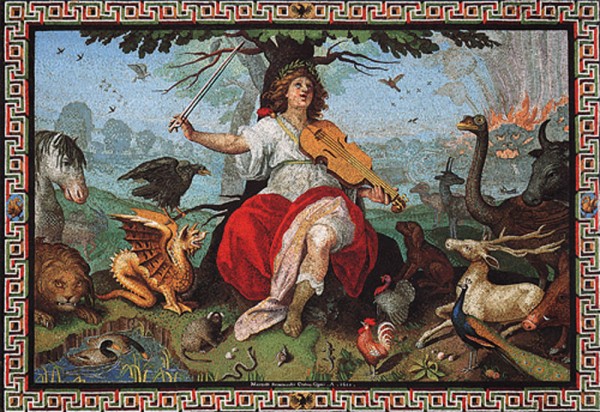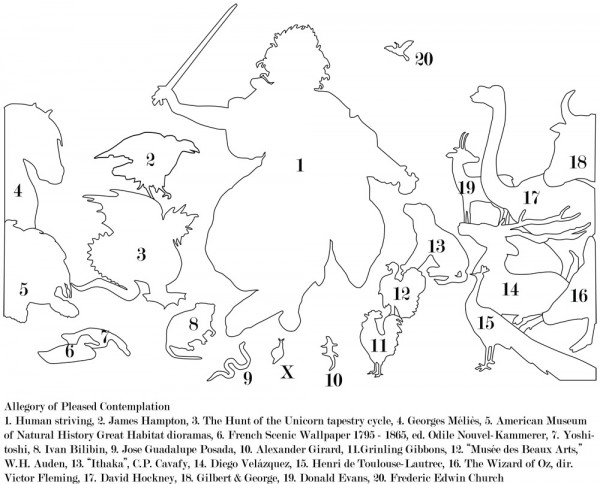Collection Rotation: Elisheva Biernoff
In our regular feature Collection Rotation, a guest selects from SFMOMA’s collection works online. This fall artists with Bay Area ties take over the series. In addition to their rotations, we asked each artist to answer poet Robert Duncan’s request to students in his 1958 Workshop in Basic Techniques and provide us with a set of influences for their work — a “constellation of their genius.” Today, please welcome Elisheva Biernoff.
1, 2, 3, 4, 5, 6, 7.
Now, that’s one way of doing it. Assign numbers, sort the pieces, and put them in their proper places.
State your name and business. Say, “This is what I am. This is what I’m here for.”
But 1, 2, 3, 4, 5, 6, 7 is only part of the story, and the sequencing makes small allowance for the pulse underneath. Who is 7, coyly sneaking into the frame? Who numbered the figures, and what did they think about Nellie Niemeyer? Where has this photograph lived, and who gave it up? The numbers slip and hop scotch, the names slur and blur, indeterminacy asserts itself. Change, uncertainty, and the unknown are the first ingredients of all stories.
Families don’t stay together, people move, houses get abandoned. Entire valleys die. We lose hansom cabs and typewriters as names and objects fall out of fashion, but still we cannot resist the world of things.

Rev. John Wheeley Gough Gutch, “The Glorious Sun Stays in His Course & Plays the Alchemyst,” King John, 1857
I collect postcards, books, and stones in order to trace the sensory world, remember and prolong my moment, my travels, my sense of awe at what I see. The story of these things may be partial and fragmentary, but it is my story.
Certain things cannot be collected; others are diminished the moment they are placed in the vitrine. The pinned butterfly can be turned over and examined, but the specimen cannot pollinate and it doesn’t come with the field it inhabits, with wheat so tall a grown man could get lost in it.
One must learn the limits of collecting. Some things are too big to hold.
We might try to bring the mountains inside, create empires in the bedroom, galaxies on the tablecloth, but we would fail.
Our handiwork is flammable and susceptible to foxing . . .
. . . and forgetting.
But it’s important to try to do things right, get the record straight.
And forge ahead.
After all, the vulgarities of life, the little exigencies of life, go on. There’s washing and dusting that must be done, seeds that must be planted, and a lot to do before it all fades away.
What is collecting but a way of saying “We are the Weikerts”? “I was here, and this is what I loved.” What is collecting, but a way of seeing certain things more closely, more tenderly, more exactingly?
What is art but the impulse to look?
Robert Duncan’s request to students in his 1958 Workshop in Basic Techniques. We asked our guests to replace “poet” with “artist”:

In The Collected Books of Jack Spicer, edited by Robin Blaser (Los Angeles: Black Sparrow, 1975), p. 358.
Elisheva Biernoff was born in 1980 in Albuquerque, New Mexico, and currently lives and works in San Francisco. She received her BA from Yale University in 2002 and her MFA from California College of the Arts in 2009. Her work has been included in exhibitions at the Contemporary Jewish Museum, Asian Arts Museum, CCA Wattis Institute for Contemporary Art, and Headlands Center for the Arts, and she has been selected for the San Francisco Arts Commission’s Art in Storefronts and Art on Market Street programs.




![Unknown, Untitled [Man holding a hat, concealed in a wheat field], n.d.; gelatin silver print, 3 3/16 in. x 5 3/8 in. (8.1 cm x 13.65 cm); Collection SFMOMA, Gift of Gordon L. Bennett Unknown, Untitled [Man holding a hat, concealed in a wheat field], n.d.](http://sfmomaopenspace.s3-us-west-2.amazonaws.com/wp-content/uploads/2013/09/untitled_man_in_wheat_field.jpg)
![Unknown, Untitled [Man holding eagle with spread wings], n.d.; gelatin silver print, 2 13/16 in. x 4 3/4 in. (7.14 cm x 12.07 cm); Collection SFMOMA, Gift of Gordon L. Bennett Unknown, Untitled [Man holding eagle with spread wings], n.d.](http://sfmomaopenspace.s3-us-west-2.amazonaws.com/wp-content/uploads/2013/09/untitled_man_with_eagle.jpg)



![Eadweard Muybridge, Untitled [Wreaths], n.d.; albumen stereograph, 3 3/8 in. x 6 15/16 in. (8.57 cm x 17.62 cm); Collection SFMOMA, Gift of Gordon L. Bennett Eadweard Muybridge, Untitled [Wreaths], n.d.](http://sfmomaopenspace.s3-us-west-2.amazonaws.com/wp-content/uploads/2013/09/muybridge_wreaths.jpg)








Comments (3)
– Killer! I’m so happy our timing worked out in Vancouver! Thanks for capturing our 3rd anniversary for us in perfect fashion. Next time, you will be required to order the Love Meat from Japadog if only because its the only one you can pronounce 🙂
Just the type of ingshit we need to fire up the debate.
Thank you Elisheva. If this collection of images and your beautiful thoughts were a thing, then I would collect that.
By the way, it seems no-one ever bothered to include in their numbering of the people in photos who was behind the camera…which presumably, was someone also near and dear. There are many explanations for this, but this missing identity is part of the story, as much as we can infer a story from an image, that always felt lacking to me. Perhaps this is the impetus for so many collections of old “photographer’s shadow” snapshots.